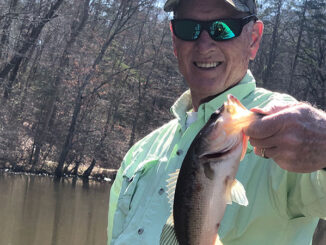 Walking to the stand in 2 feet of snow was new to me. I hadn’t had the chance too many times to hunt bucks in the snow, and I was thrilled to get to do it. I was hunting with Ralph and Vicki Cianciarulo at their farm in Illinois for late season bucks. Camera man Chad Turrell was with me to document the hunt. The temperature was 18 degrees Fahrenheit. This southern boy had on everything I brought with me to stay warm during the hunt.
Walking to the stand in 2 feet of snow was new to me. I hadn’t had the chance too many times to hunt bucks in the snow, and I was thrilled to get to do it. I was hunting with Ralph and Vicki Cianciarulo at their farm in Illinois for late season bucks. Camera man Chad Turrell was with me to document the hunt. The temperature was 18 degrees Fahrenheit. This southern boy had on everything I brought with me to stay warm during the hunt.
During the 3 days I hunted these bucks, I learned more about late season hunting than I had the previous 20 years. As the mercury drops, there is only one thing on a buck’s mind, and that is food. The rut is over, his role in spreading his gene pool is done, and he is hungry.
Late season archery tactics are similar to early season. Find the food and find the deer. It really is that simple.
Chad and I sat in the tree watching the snow fall to the ground. We spotted movement at about 80 yards away as a 10-point buck was making his way from his bed to the soybean field 200 yards to our west.
The night before, we sat in the field and watched more than 70 deer pour into the field from this direction. We made the decision to set up inside the woods and intercept them on their way to the field.
The buck fed leisurely as he walked along, and I knew he would get to my shooting lane at 32 yards. If everything went as planned, this would be the biggest buck ever taken with my bow, and my first on camera.
The buck stepped into my lane. Drawing the bow, I settled the pin, released the arrow, and promptly shot right over his back!
The buck trotted off and a grunt settled him. To our surprise, a group of does was making its way toward us, and he caught eye of them. He circled right back to within 27 yards, and my arrow found its mark.
Living in the Carolinas, hunters rarely have the opportunity to hunt in snow, but the cold temperatures are not rare. The same factor that is driving those bucks in Illinois are the same ones driving them here. Food. Find the food and find the bucks.
Food Plots

Hunting with archery equipment in the late season means you’re better off skipping the morning, when you’ll likely scare deer away from their food sources. Hunt afternoons instead.
One of the best late season food plot crops is soybeans. Many southerners consider this an early season source, and it is. However, allowing the beans to dry on the stalk and leaving them for the deer is a great late season food source.
Other good food plots for late season include brassicas like turnips, rutabagas, and radishes.
Native foods
If you are like me and do not have food plots, finding native food sources can spell all the difference. Some of the late season food sources to locate include honey locust, Catalpa, pin oak, red oak, and other late-dropping hard mast crops. The occasional beech nut is also a good crop to hunt if you can find them dropping.
Bait
Where legal, the use of placed food sources is also a great method of both keeping your deer herd fed and intercepting a hungry buck. Most folks use either whole cob corn or shelled corn to attract deer. The key to keeping bucks visiting these locations is making sure the food never runs out. Placing corn on the ground in a likely location has helped many hunters. Whether you are placing the corn, using a gravity feeder or timed feeder is irrelevant as long as the food never runs out. As soon as it runs out, they find another source elsewhere.
Morning hunts here are usually fruitless because the deer are feeding when you are making your way in, and you will likely spook them. If you are bowhunting near a food source, hunt afternoons only.





Be the first to comment